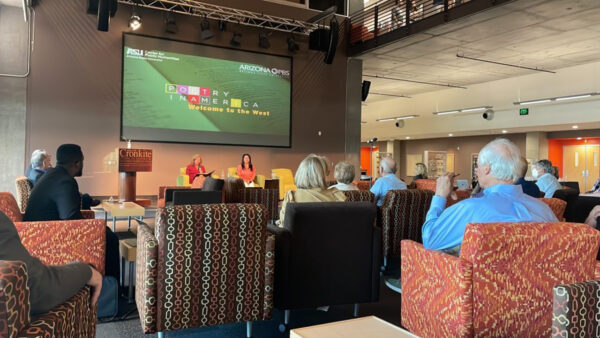Frontline “The Meth Epidemic”
Jan. 24, 2012
Speed. Meth. Glass. On the street, methamphetamine has many names. What started as a fad among West Coast motorcycle gangs in the 1970s has spread across the United States, and despite lawmakers’ calls for action, the drug is now more potent, and more destructive, than at any time in the past decade. In “The Meth Epidemic,” Frontline, in association with The Oregonian, investigates the meth rampage in America: the appalling impact on individuals, families and communities, and the difficulty of controlling an essential ingredient in meth — ephedrine and pseudoephedrine — sold legally in over-the-counter cold remedies. Frontline “The Meth Epidemic” airs Tuesday, January 24, 2012 at 9 p.m. on Eight, Arizona PBS.
In Congress, a bipartisan coalition has called for international controls on ephedrine and pseudoephedrine, either of which is essential for making meth. Many states have forced cold medicines that contain these ingredients off retail shelves and behind the pharmacy counter, a move that may become a national requirement.
Methamphetamine abuse started in California and Oregon, but spread rapidly into the Midwest. Now the drug has reached the East Coast. “Meth has made a steady march across the United States,” says Steve Suo, a reporter for Portland’s The Oregonian,who has followed meth from the beginning. “Right now you have Mexican methamphetamine flooding in through Atlanta, and from there [it] fans out both south and north.” The discovery of meth labs in states from Maine to Florida foreshadows a new crisis on the East Coast: “They can expect to see increased car theft, increased identity theft … domestic violence, child neglect, drug overdoses and just a lot of mayhem,” says Suo. Indeed, statistics show that meth can trigger a surge in other crimes: In Oregon, a staggering 85 percent of property crime, as well as a majority of muggings, car thefts and identity thefts, has been linked to the drug.
Meth’s destructive power comes from its impact on the user’s brain. “Dopamine is the brain’s primary pleasure chemical,” says UCLA professor and meth expert Dr. Richard Rawson. “If you take a hit on a pipe or an injection of methamphetamine, you get an increase from zero to about 1,250 units. … This produces an extreme peak of euphoria that people describe as something like they’ve never experienced.” Researchers have found that meth creates this high by destroying the very part of the brain that generates dopamine — and makes them unable to feel pleasure from anything except more meth. “It actually changes how the brain operates,” Rawson continues. “It’s a wonder anyone ever gets off meth.” According to the World Health Organization, meth abuse worldwide is worse than that of cocaine and heroin combined.
“The Meth Epidemic”tells the story of two potential solutions to the crisis and examines why neither was fully tried. In the mid-80s, the U.S. Drug Enforcement Administration first proposed controlling the retail sale of ephedrine and pseudoephedrine in cold medicines by having customers register at the counter and limiting how much they could buy. Pharmaceutical companies, however, resisted the DEA’s plan. Alan Rexinger, a lobbyist for the pharmaceutical industry, felt the DEA was overreacting and unfairly punishing a legitimate business: “They have a different way of thinking. DEA agents carry guns; DEA agents are killed in the jungles of South America. But when you’re working in Congress, you don’t need to carry a gun. We felt like we were being treated just like a Colombian drug lord.” Meanwhile, Gene Haislip, a former deputy administrator at the DEA, says, “They live in the business community, where the name of the game is to make money and sell product. They’re highly skilled, very well organized and very well funded, and they can be quite formidable.” Faced with a choice, the White House and Congress ultimately exempted cold medication from the regulatory proposals.
The second DEA approach was to regulate the source of the ingredients. Ephedrine and pseudoephedrine are highly sophisticated chemicals that can only be produced in a handful of huge, legal laboratories worldwide, thus making them potentially easy to track. But with Washington’s primary focus on cocaine and heroin, meth took a bureaucratic back seat.
The government’s focus shifted after 1994, when a customs agent inadvertently discovered a large, illicit shipment of ephedrine on a plane traveling from India to Mexico. During an 18-month period in the early 1990s, a Mexican drug cartel had purchased 170 tons of ephedrine from Indian manufacturers and smuggled it into the United States, where it was turned into as much as two billion hits of meth. This accidental find was a hopeful moment in the history of the meth epidemic, and efforts to cut off the drug lord’s supply escalated. Once U.S. authorities asked the manufacturers to cease exports to the Mexican cartel, the chemicals became more expensive and the purity of meth on America’s streets started to plunge — along with addiction rates. “We at Krebs Biochemicals would have been happy if the DEA or other American authorities had told us, ‘You can deal with these guys, they’re OK, but don’t deal with these guys,’” says Dr. R.T. Ravi, an administrator at the company. “We would rather that our product did not fall into the wrong hands.”
Soon, however, the cartel would be back in business. Cold medicines remained unregulated for years, and the cartel took advantage of the situation, scooping up pills by the tens of thousands, even punching them out of their packets and distilling the ephedrine and pseudoephedrine in them to make meth. Today, the number of meth addicts is skyrocketing: With 1.5 million addicts in the U.S. alone and millions more around the world, the United Nations calls meth the most abused hard drug on earth.
)






















